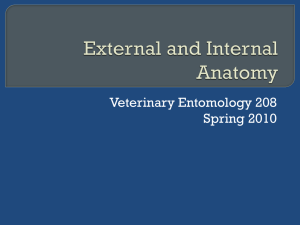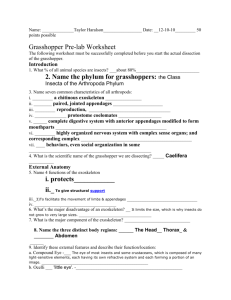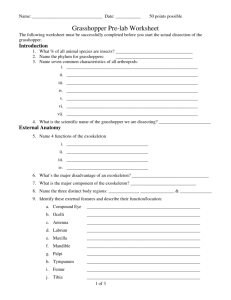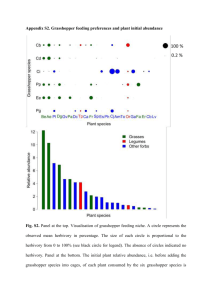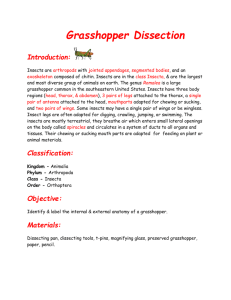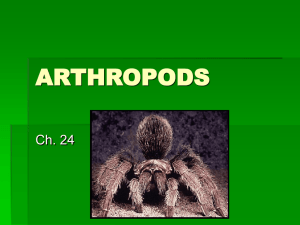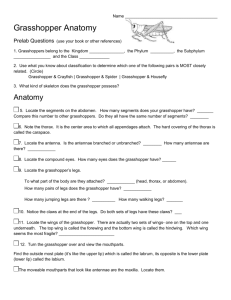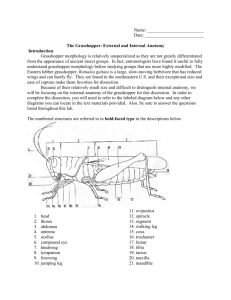Grasshopper Dissection Lab: Anatomy & Adaptations
advertisement
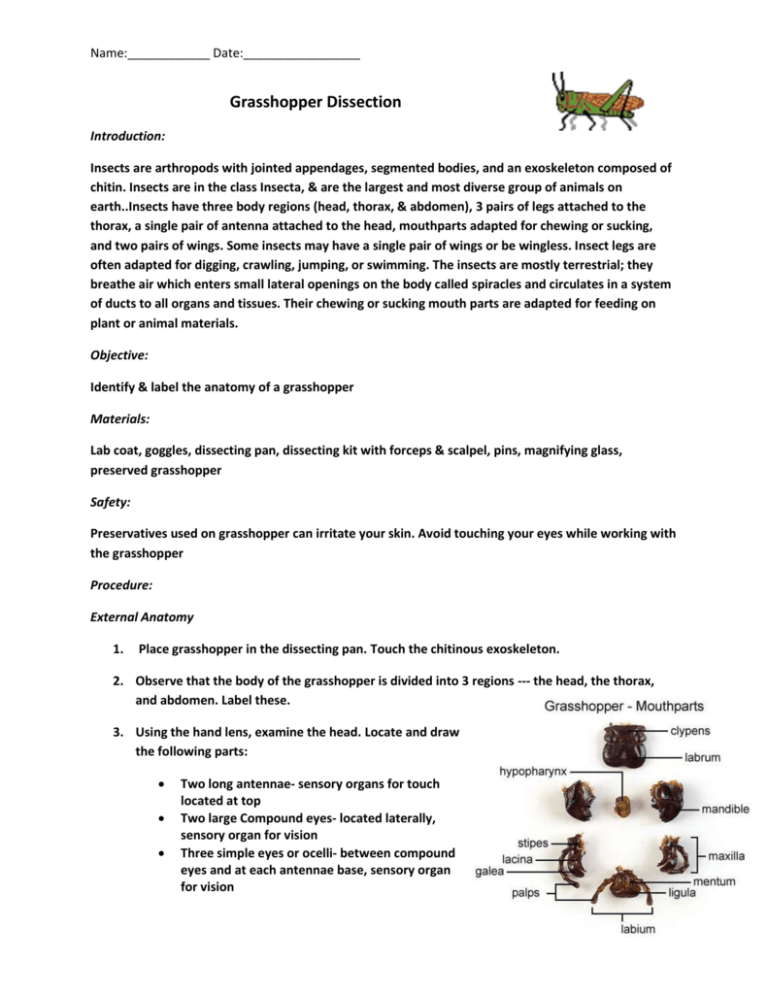
Name:____________ Date:_________________ Grasshopper Dissection Introduction: Insects are arthropods with jointed appendages, segmented bodies, and an exoskeleton composed of chitin. Insects are in the class Insecta, & are the largest and most diverse group of animals on earth..Insects have three body regions (head, thorax, & abdomen), 3 pairs of legs attached to the thorax, a single pair of antenna attached to the head, mouthparts adapted for chewing or sucking, and two pairs of wings. Some insects may have a single pair of wings or be wingless. Insect legs are often adapted for digging, crawling, jumping, or swimming. The insects are mostly terrestrial; they breathe air which enters small lateral openings on the body called spiracles and circulates in a system of ducts to all organs and tissues. Their chewing or sucking mouth parts are adapted for feeding on plant or animal materials. Objective: Identify & label the anatomy of a grasshopper Materials: Lab coat, goggles, dissecting pan, dissecting kit with forceps & scalpel, pins, magnifying glass, preserved grasshopper Safety: Preservatives used on grasshopper can irritate your skin. Avoid touching your eyes while working with the grasshopper Procedure: External Anatomy 1. Place grasshopper in the dissecting pan. Touch the chitinous exoskeleton. 2. Observe that the body of the grasshopper is divided into 3 regions --- the head, the thorax, and abdomen. Label these. 3. Using the hand lens, examine the head. Locate and draw the following parts: Two long antennae- sensory organs for touch located at top Two large Compound eyes- located laterally, sensory organ for vision Three simple eyes or ocelli- between compound eyes and at each antennae base, sensory organ for vision Name:____________ Date:_________________ Mouth parts - Labrum (upper lip), mandibles (jaws) below the labrum, maxillae located behind the mandibles to help cut & hold food, and the lower lip or labium 4. Observe and label the thorax in your observations. One pair of legs is attached to each segment. Forelegs, or first two pairs of legs are for walking. Last pair known as hind legs which are larger and used for jumping. The coxa connects the femur (thickest part of the leg) to the grasshopper’s body. A slender spiny tibia connects femur to tarsal segments (lower part of the leg) 5. Notice the wings. Forewings have a leathery appearance & protect the hind wings which are used for flying. 6. Raise both pairs of wings and locate the first abdominal segment. Locate and label the drum shaped tympanic membrane or eardrum. This is a sensory organ used for sound. 7. Using a magnifying glass, locate the spiracles or tiny pores for respiration on lateral side of the abdominal segments. Label these openings into the gas exchange or respiratory system. 8. Determine if your grasshopper is a male or female by looking at the end of the abdomen. Females have a tapered abdomen that ends in a pointed egg laying tube called the ovipositor. The claw like structure digs a hole where eggs are laid. Label it. Male have a more rounded abdomen that turns upward. Name:____________ Date:_________________ Grasshopper Dissection Questions 1. Describe the respiratory system of a grasshopper. 2. How do simple and compound eyes differ? 3. Compare and contrast the legs in terms of form and function. 4. How is the color of the grasshopper an adaptation to where it lives? 5. How is the grasshopper adapted to detect moving objects in the environment? 6. Of the three body regions of the grasshopper, which one is specialized for locomotion? Explain your reasoning. 7. How can a grasshopper’s exoskeleton be both an advantage and a disadvantage?
